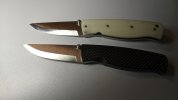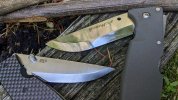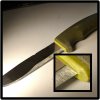So I was looking at a Companion and because I like to overthink things, I started wondering about some potential issues with it.
The main thing I'm wondering about is the fact that the scandi grind goes straight up and in to the handle. The most obvious potential issue with this is contamination by dirt/grit and germs and such, and the difficulty of effectively cleaning this area with any real confidence in the end result.
The next potential problem with this area deals with sharpening. In order to sharpen the knife, you are going to have to get the stone all the way up against the handle. This would not be an issue if there was such a thing as a perfect 90 degree angle in real life. Over time what I'm worried about is the gradual appearance of a small raised section of unsharpened material right up against the handle. Does that make sense? Also what will probably happen is that the portion of the plastic handle that meets the grind will get beat up from repeated contact with the stones.
Am I just making something out of nothing, or are these real issues?
Oh, and yes before anybody posts about it, I am aware that this knife comes from the factory with a micro bevel, and that it should probably be kept with one in order to have a suitably durable edge.
The main thing I'm wondering about is the fact that the scandi grind goes straight up and in to the handle. The most obvious potential issue with this is contamination by dirt/grit and germs and such, and the difficulty of effectively cleaning this area with any real confidence in the end result.
The next potential problem with this area deals with sharpening. In order to sharpen the knife, you are going to have to get the stone all the way up against the handle. This would not be an issue if there was such a thing as a perfect 90 degree angle in real life. Over time what I'm worried about is the gradual appearance of a small raised section of unsharpened material right up against the handle. Does that make sense? Also what will probably happen is that the portion of the plastic handle that meets the grind will get beat up from repeated contact with the stones.
Am I just making something out of nothing, or are these real issues?
Oh, and yes before anybody posts about it, I am aware that this knife comes from the factory with a micro bevel, and that it should probably be kept with one in order to have a suitably durable edge.



